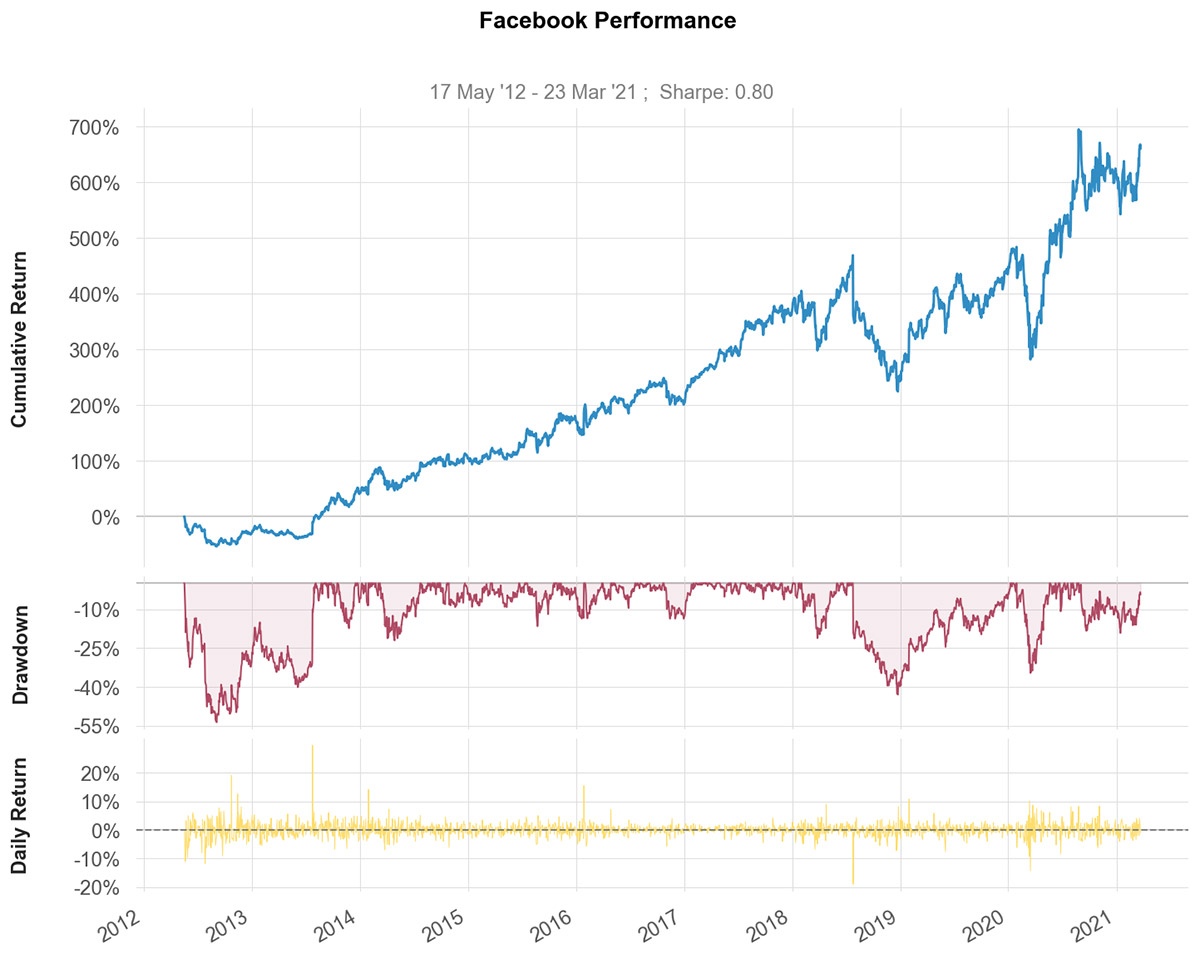Portfolio analytics for quants
Project description








QuantStats: Portfolio analytics for quants
QuantStats Python library that performs portfolio profiling, allowing quants and portfolio managers to understand their performance better by providing them with in-depth analytics and risk metrics.
QuantStats is comprised of 3 main modules:
quantstats.stats - for calculating various performance metrics, like Sharpe ratio, Win rate, Volatility, etc.
quantstats.plots - for visualizing performance, drawdowns, rolling statistics, monthly returns, etc.
quantstats.reports - for generating metrics reports, batch plotting, and creating tear sheets that can be saved as an HTML file.
Here’s an example of a simple tear sheet analyzing a strategy:
Quick Start
%matplotlib inline
import quantstats as qs
# extend pandas functionality with metrics, etc.
qs.extend_pandas()
# fetch the daily returns for a stock
stock = qs.utils.download_returns('FB')
# show sharpe ratio
qs.stats.sharpe(stock)
# or using extend_pandas() :)
stock.sharpe()Output:
0.8135304438803402Visualize stock performance
qs.plots.snapshot(stock, title='Facebook Performance')
# can also be called via:
# stock.plot_snapshot(title='Facebook Performance')Output:

Creating a report
You can create 7 different report tearsheets:
qs.reports.metrics(mode='basic|full", ...) - shows basic/full metrics
qs.reports.plots(mode='basic|full", ...) - shows basic/full plots
qs.reports.basic(...) - shows basic metrics and plots
qs.reports.full(...) - shows full metrics and plots
qs.reports.html(...) - generates a complete report as html
Let’ create an html tearsheet
(benchmark can be a pandas Series or ticker)
qs.reports.html(stock, "SPY")Output will generate something like this:

To view a complete list of available methods, run
[f for f in dir(qs.stats) if f[0] != '_']['avg_loss',
'avg_return',
'avg_win',
'best',
'cagr',
'calmar',
'common_sense_ratio',
'comp',
'compare',
'compsum',
'conditional_value_at_risk',
'consecutive_losses',
'consecutive_wins',
'cpc_index',
'cvar',
'drawdown_details',
'expected_return',
'expected_shortfall',
'exposure',
'gain_to_pain_ratio',
'geometric_mean',
'ghpr',
'greeks',
'implied_volatility',
'information_ratio',
'kelly_criterion',
'kurtosis',
'max_drawdown',
'monthly_returns',
'outlier_loss_ratio',
'outlier_win_ratio',
'outliers',
'payoff_ratio',
'profit_factor',
'profit_ratio',
'r2',
'r_squared',
'rar',
'recovery_factor',
'remove_outliers',
'risk_of_ruin',
'risk_return_ratio',
'rolling_greeks',
'ror',
'sharpe',
'skew',
'sortino',
'adjusted_sortino',
'tail_ratio',
'to_drawdown_series',
'ulcer_index',
'ulcer_performance_index',
'upi',
'utils',
'value_at_risk',
'var',
'volatility',
'win_loss_ratio',
'win_rate',
'worst'][f for f in dir(qs.plots) if f[0] != '_']['daily_returns',
'distribution',
'drawdown',
'drawdowns_periods',
'earnings',
'histogram',
'log_returns',
'monthly_heatmap',
'returns',
'rolling_beta',
'rolling_sharpe',
'rolling_sortino',
'rolling_volatility',
'snapshot',
'yearly_returns']*** Full documenttion coming soon ***
In the meantime, you can get insights as to optional parameters for each method, by using Python’s help method:
help(qs.stats.conditional_value_at_risk)Help on function conditional_value_at_risk in module quantstats.stats:
conditional_value_at_risk(returns, sigma=1, confidence=0.99)
calculats the conditional daily value-at-risk (aka expected shortfall)
quantifies the amount of tail risk an investmentInstallation
Install using pip:
$ pip install quantstats --upgrade --no-cache-dirInstall using conda:
$ conda install -c ranaroussi quantstatsRequirements
Questions?
This is a new library… If you find a bug, please open an issue in this repository.
If you’d like to contribute, a great place to look is the issues marked with help-wanted.
Known Issues
For some reason, I couldn’t find a way to tell seaborn not to return the monthly returns heatmap when instructed to save - so even if you save the plot (by passing savefig={...}) it will still show the plot.
Legal Stuff
QuantStats is distributed under the Apache Software License. See the LICENSE.txt file in the release for details.
P.S.
Please drop me a note with any feedback you have.
Ran Aroussi
Project details
Release history Release notifications | RSS feed
Download files
Download the file for your platform. If you're not sure which to choose, learn more about installing packages.
Source Distribution
Built Distribution
File details
Details for the file QuantStats-0.0.56.tar.gz.
File metadata
- Download URL: QuantStats-0.0.56.tar.gz
- Upload date:
- Size: 36.3 kB
- Tags: Source
- Uploaded using Trusted Publishing? No
- Uploaded via: twine/4.0.0 CPython/3.10.4
File hashes
| Algorithm | Hash digest | |
|---|---|---|
| SHA256 | e4ac4f428da8cc15b3c4766a50c78a7f515fff74093513fe75157bad9fc7280a |
|
| MD5 | b6161319b62264aaf14169bf7d2eeb67 |
|
| BLAKE2b-256 | cea81ab62a34ebe450f2ca79d8b1cfb8fdf9cb9165620f50a1d875fc77a6d2ff |
File details
Details for the file QuantStats-0.0.56-py2.py3-none-any.whl.
File metadata
- Download URL: QuantStats-0.0.56-py2.py3-none-any.whl
- Upload date:
- Size: 41.3 kB
- Tags: Python 2, Python 3
- Uploaded using Trusted Publishing? No
- Uploaded via: twine/4.0.0 CPython/3.10.4
File hashes
| Algorithm | Hash digest | |
|---|---|---|
| SHA256 | 5cd1b1ec84533ee54298818ce0dbf8a980cdf5d076ee3c1111bb87fa4c0d49b1 |
|
| MD5 | 4988c58e4a84244e99c763786cd88347 |
|
| BLAKE2b-256 | 6c37af8c7846f61b8ea6d7fc338a7920627f99c014829ee1475043fa80616d41 |











